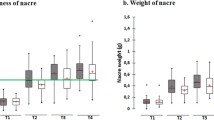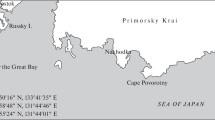Abstract
Grafting experiments with newly settled larvae and with adult colonies of Pocillopora damicornis were performed. When pairs of newly settled larvae released from different colonies were kept in contact, they fused to form an aggregated colony. Even newly settled larvae derived from colonies belonging to different color morphs fused with each other and no sign of allogeneic rejection was observed. However, when branches of adult colonies belonging to different color morphs were kept in contact, they did not fuse. Fusion was observed only when branches derived from the same colony were paired. The present results suggest that juvenile corals lack the functional histocompatibility system as shown by adult colonies.
Similar content being viewed by others
References
Atoda K (1947a) The larva and postlarval development of some reef building corals. I. Pocillopora damicornis cespitosa (Dana). Sci Rep Tohoku Univ Ser 4:18:24–47
Atoda K (1947b) The larva and postlarval development of some reef building corals. II. Stylophora pistillata (Esper). Sci Rep Tohoku Univ Ser 4 18:48–64
Atoda K (1951 a) The larva and postlarval development of some reef building corals. IV. Galaxea aspera Quelch. J Morphol 89:17–30
Atoda K (1951 b) The larva and postlarval development of some reef building corals. V. Seriatopora hystrix Dana. Sci Rep Tohoku Univ Ser 4 19:33–39
Bak RPM, Criens SR (1982) Experimental fusion in Atlantic Acropora (Scleractinia). Mar Biol Let 3:67–72
Bothwell AM (1981) Fragmentation, a means of asexual reproduction and dispersal in the coral genus Acropora (Sleractinia: Astrocoeniida: Acroporidae)—a preliminary report. Proc 4th Int Coral Reef Symp 2:137–144
Cooper EL (1976) Comparative immunology. Prentice-Hall Inc, Englewood Cliffs New Jersey, pp 338
Hidaka M, Yamazato K (1984) Intraspecific interactions in a scleractinian coral Galaxea fascicularis: induced formation of sweeper tentacles. Coral Reefs 3:77–85
Hildemann WH, Linthicum DS, Vann DC (1975) Transplantation and immunoincompatibility reactions among reef-building corals. Immunogenetics 2:269–284
Hildemann WH, Raison RL, Hull CJ, Akaka L, Okamoto J, Cheung G (1977) Tissue transplantation immunity in corals. Proc 3rd Int Coral Reef Symp 1:537–543
Hildemann WH, Bigger CH, Johnston IS, Jokiel PL (1980) Characteristics of transplantation immunity in the sponge, Callyspongia diffusa. Transplantation 30:362–367
Johnston IS, Jokiel PL, Bigger CH, Hildemann WH (1981) The influence of temperature on the kinetics of allograft reactions in a tropical sponge and a reef coral. Biol Bull 160:280–291
Jokiel PL, Hildemann WH, Bigger CH (1983) Clonal population structure of two sympatric species of the reef coral Montipora. Bull Mar Sci 33:181–187
Neigel JE, Avise JC (1983) Clonal diversity and population structure in a reef building coral, Acropora cervicornis: self-recognition analysis and demographic interpretation. Evolution 37:437–453
Potts DC (1976) Growth interactions among morphological variants of the coral Acropora palifera. In: Mackie GO (ed) Coelenterate ecology and behaviour. Plenum Press, New York, pp 79–88
Potts DC (1978) Differentiation in coral populations. Atoll Res Bull 220:55–74
Richmond RH, Jokiel PL (1984) Lunar periodicity in larva release in the reef coral Pocillopora damicornis at Enewetak and Hawaii. Bull Mar Sci 34:280–287
Rinkevich B, Loya Y (1983) Intraspecific competitive networks in the Red Sea coral Stylophora pistillata. Coral Reefs 1:161–172
Sammarco PW (1982) Echinoid grazing as a structuring force in coral communities: Whole reef manipulations. J Exp Mar Biol Ecol 61:31–55
Stephenson TA (1931) Development and the formation of colonies in Pocilloporo and Porites, part 1. Great Barrier Reef Expedition 1928–1929. Sci Rep 3:113–134
Stoddart JA (1983) The axexual production of planulae in the coral Pocillopora damicornis. Mar Biol 76:279–284
Stoddart JA (1984) Genetical structure within populations of the coral Pocillopora damicornis. Mar Biol 81:19–30
Author information
Authors and Affiliations
Rights and permissions
About this article
Cite this article
Hidaka, M. Tissue compatibility between colonies and between newly settled larvae of Pocillopora damicornis . Coral Reefs 4, 111–116 (1985). https://doi.org/10.1007/BF00300869
Accepted:
Issue Date:
DOI: https://doi.org/10.1007/BF00300869




